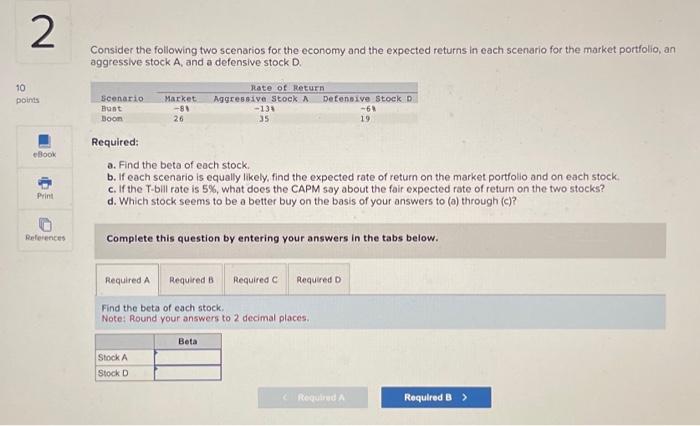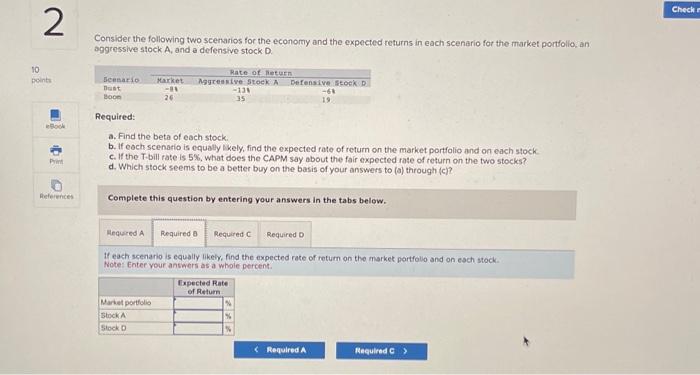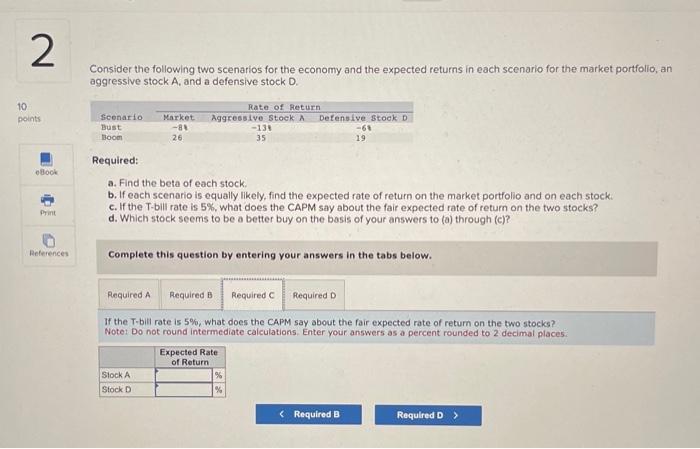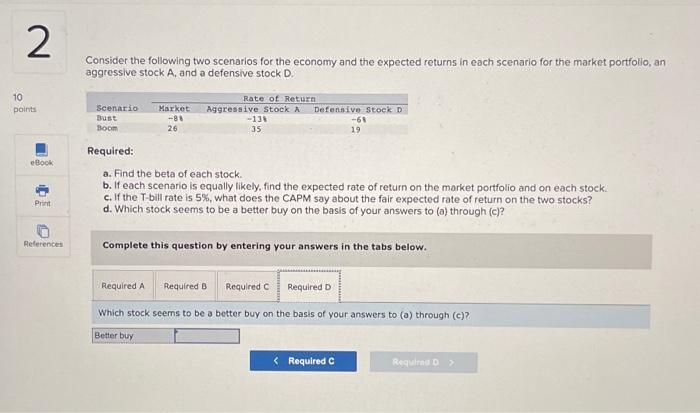need a,b,c,d

Consider the following two scenarios for the economy and the expected returns in each scenario for the market portfolio, an aggressive stock A, and a defensive stock D. Required: a. Find the beta of each stock. b. If each scenario is equally likely, find the expected rate of return on the market portfolio and on each stock. c. If the T-bill rate is 5%, what does the CAPM say about the fair expected rate of return on the two stocks? d. Which stock seems to be a better buy on the basis of your answers to (a) through (c)? Complete this question by entering your answers in the tabs below. Find the beta of each stock. Note: Round your answers to 2 decimal places. Consider the following two scenarios for the economy and the expected returns in each scenario for the market portfolio, an aggressive stock A, and a defensive stock D. Required: a. Find the beta of each stock. b. If eoch scenario is equally wely, find the expected rate of retum on the market portfolio and on each stock. c. If the T.bill rate is 5%, what does the CAPM say about the fair expected rate of return on the two stocks? d. Which stock seems to be a better buy on the basis of your answers to (a) through (c)? Complete this question by entering your answers in the tabs below. If each scenario is equally likefy, find the expected rate of rotum on the market portfollo and on esch stock. Note: Enter your answers as a whole percent. Consider the following two scenarios for the economy and the expected returns in each scenario for the market portfolio, an iggressive stock A, and a defensive stock D. Required: a. Find the beta of each stock. b. If each scenario is equally likely, find the expected rate of return on the market portfolio and on each stock. c. If the T-bill rate is 5%, what does the CAPM say about the fair expected rate of return on the two stocks? d. Which stock seems to be a better buy on the basis of your answers to (a) through (c)? Complete this question by entering your answers in the tabs below. If the T-bill rate is 5%, what does the CAPM say about the fair expected rate of retum on the two stocks? Note: Do not round intermediate caiculations. Enter your answers as a percent rounded to 2 decimal places. Consider the following two scenarios for the economy and the expected returns in each scenario for the market portfolo, an aggressive stock A, and a defensive stock D. Required: a. Find the beta of each stock. b. If each scenario is equally likely. find the expected rate of return on the market portfolio and on each stock. c. If the T-bill rate is 5%, what does the CAPM say about the fair expected rate of return on the two stocks? d. Which stock seems to be a better buy on the basis of your answers to (a) through (c)? Complete this question by entering your answers in the tabs below. Which stock seems to be a better buy on the basis of your answers to (a) through (c)? Consider the following two scenarios for the economy and the expected returns in each scenario for the market portfolio, an aggressive stock A, and a defensive stock D. Required: a. Find the beta of each stock. b. If each scenario is equally likely, find the expected rate of return on the market portfolio and on each stock. c. If the T-bill rate is 5%, what does the CAPM say about the fair expected rate of return on the two stocks? d. Which stock seems to be a better buy on the basis of your answers to (a) through (c)? Complete this question by entering your answers in the tabs below. Find the beta of each stock. Note: Round your answers to 2 decimal places. Consider the following two scenarios for the economy and the expected returns in each scenario for the market portfolio, an aggressive stock A, and a defensive stock D. Required: a. Find the beta of each stock. b. If eoch scenario is equally wely, find the expected rate of retum on the market portfolio and on each stock. c. If the T.bill rate is 5%, what does the CAPM say about the fair expected rate of return on the two stocks? d. Which stock seems to be a better buy on the basis of your answers to (a) through (c)? Complete this question by entering your answers in the tabs below. If each scenario is equally likefy, find the expected rate of rotum on the market portfollo and on esch stock. Note: Enter your answers as a whole percent. Consider the following two scenarios for the economy and the expected returns in each scenario for the market portfolio, an iggressive stock A, and a defensive stock D. Required: a. Find the beta of each stock. b. If each scenario is equally likely, find the expected rate of return on the market portfolio and on each stock. c. If the T-bill rate is 5%, what does the CAPM say about the fair expected rate of return on the two stocks? d. Which stock seems to be a better buy on the basis of your answers to (a) through (c)? Complete this question by entering your answers in the tabs below. If the T-bill rate is 5%, what does the CAPM say about the fair expected rate of retum on the two stocks? Note: Do not round intermediate caiculations. Enter your answers as a percent rounded to 2 decimal places. Consider the following two scenarios for the economy and the expected returns in each scenario for the market portfolo, an aggressive stock A, and a defensive stock D. Required: a. Find the beta of each stock. b. If each scenario is equally likely. find the expected rate of return on the market portfolio and on each stock. c. If the T-bill rate is 5%, what does the CAPM say about the fair expected rate of return on the two stocks? d. Which stock seems to be a better buy on the basis of your answers to (a) through (c)? Complete this question by entering your answers in the tabs below. Which stock seems to be a better buy on the basis of your answers to (a) through (c)











